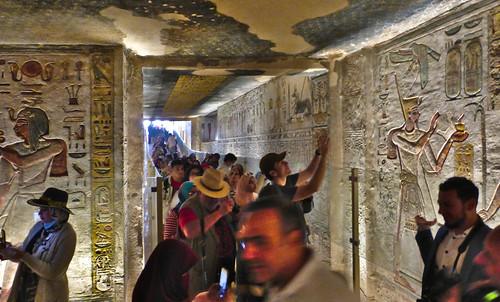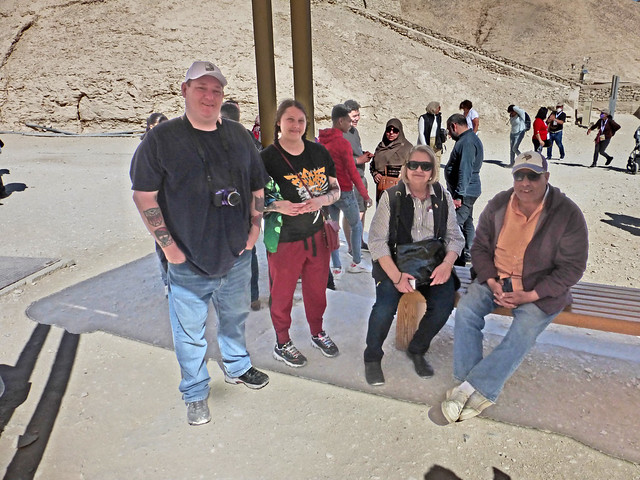Our final tomb visit was to KV11, Ramses III. He ruled from 1186 - 1155 BC, and is considered the last significant monarch of the New Kingdom. He ruled during a time of war, defeating the "sea people"; he suffered through some tough economic times and may have succumbed to a knife wound to the neck.


This tomb is undergoing some restoration at the bottom so it is closed off at the burial chamber. The rather nice looking red granite sarcophagus that should be there is found in Paris at the Louvre. There are some very attractive paintings on the walls in the tunnel leading to the bottom, so there are lots of people posing for pictures.

I managed find a small pause in the stream of folks to get a picture of Amy and Terry.

Of the three tombs that we toured, this may have the best photo opportunities.




After a brief rest, we were ready to move on to our next stop.

More photos at this Flickr Album, of course.
Update:
A bit of research led me to this photo of the bottom of the
sarcophagus on Wikipedia. (Greudin, Public domain, via Wikimedia
Commons.) I then enhanced it a bit with Photoshop.
The blocked entry to the burial chamber at the bottom of the entrance tunnel, with its "No Photos" sign and a web link to a restoration project, was quite intriguing to me.


The famous sarcophagus that was removed from the tomb of Ramesses III in the Valley of the Kings (KV 11) in the beginning of the 19th century is nowadays housed in two different European Museums: while the lid is displayed in the Fitzwilliam Museum in Cambridge (Inv. No. E.1.1823), the coffer is to be seen in the Musée du Louvre in Paris (Inv. No. D1).
The project team web site explains the basis for the restoration of the burial chamber as follows:
Since thousands of years, the Valley of the Kings, which is a dried out Wadi (river bed), suffers from flash floods. The sarcophagus chamber (hall J) of KV 11 has been flooded after heavy rain falls between 1890 and 1910. Nowadays, the chamber is heavily destroyed and filled with debris. the project plans to clear Hall J in order to make it accessible for researchers, conservators and for the public in near future.
Well, "near future" means different things to different people. The project appears to be moving at a conservative academic pace since serious work began in 2017. Unfortunately, at this rate, I don't expect to tour the restored burial chamber during my lifetime. Of course, it is yielding a number of academic papers as it progresses and I strongly recommend visiting the two links above.







2 comments:
shisha plus
chicago limo service
tax home services
yahala travel
vape shops wholesale
It still blows my mind that you can take pix in the tombs. That wasn't possible when we were there in 2015.
Post a Comment